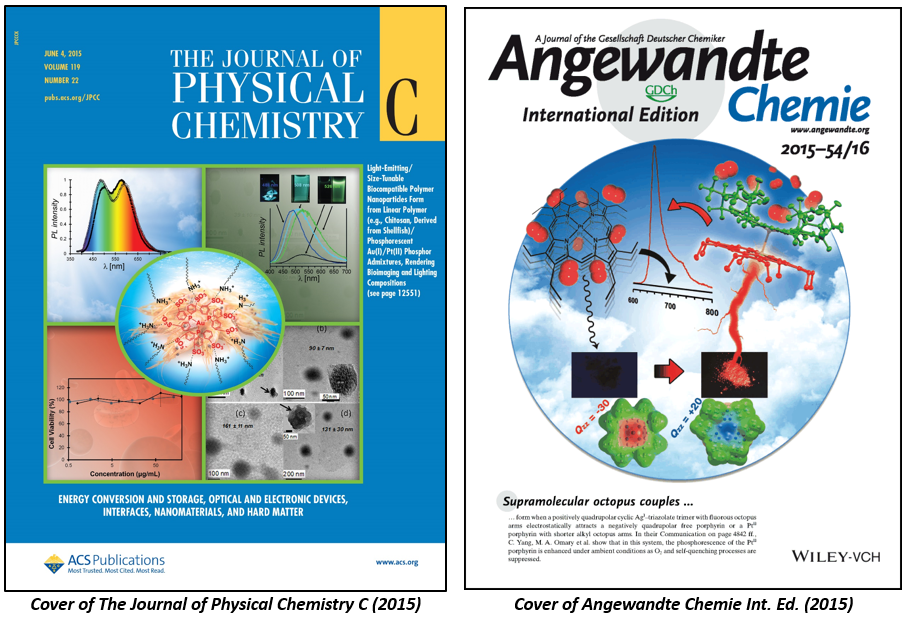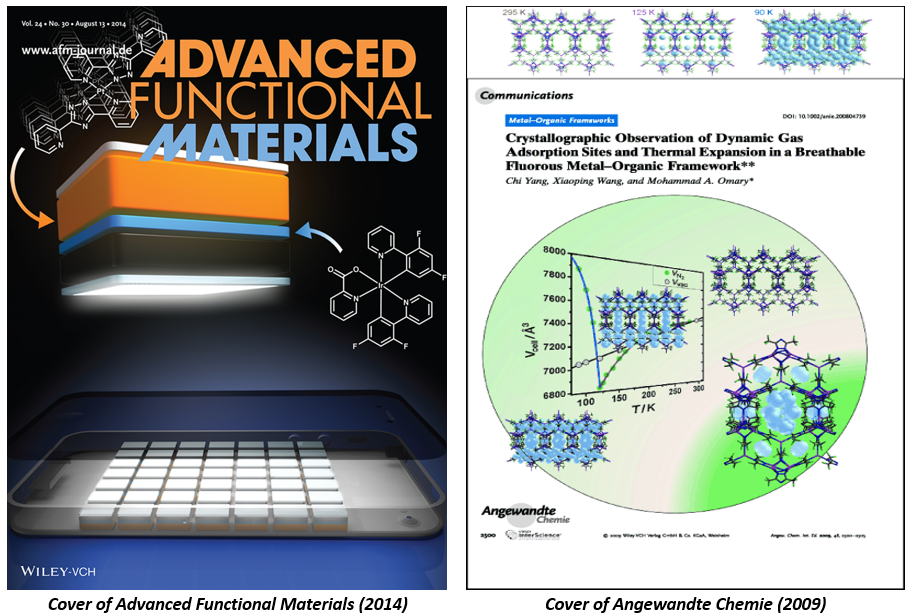

 The Omary group is pursuing research on the design of metal-organic materials for
energy-saving and biomedical applications based on advances in fundamental sciences.
Group facilities include modern steady-state and time-resolved photo- and electro-luminescence,
UV-Vis-NIR absorption and diffuse reflectance, Raman and FTIR spectrometers, organic
and inorganic synthetic facilities including microwave reactors, and high- and low-pressure
adsorption analyzers for gas storage.
The Omary group is pursuing research on the design of metal-organic materials for
energy-saving and biomedical applications based on advances in fundamental sciences.
Group facilities include modern steady-state and time-resolved photo- and electro-luminescence,
UV-Vis-NIR absorption and diffuse reflectance, Raman and FTIR spectrometers, organic
and inorganic synthetic facilities including microwave reactors, and high- and low-pressure
adsorption analyzers for gas storage.
Molecular Electronics
Next-generation electronic devices will rely on new molecular materials that outperform current state-of-the-art materials in terms of light-emitting, photovoltaic, and semiconducting properties. For organic light-emitting diodes (OLEDs), maximum quantum efficiency of 100% can be attained by phosphorescent complexes compared to 25% for conventional organic fluorophores. Our design strategies target new materials with room-temperature phosphorescence in the solid state utilizing heavy-atom effects or metal-centered phosphorescent states in d10 and d8 transition metal ions or trivalent lanthanides. For photovoltaics, we are synthesizing "black absorbers" that strongly and continuously absorb across the ultraviolet, visible and near infrared solar radiation due to multiple chromophoric centers in the same complex or a donor-acceptor binary adduct. For transistors, n- and p-type semiconducting behavior is endowed by judicious metal/ligand/substituent combinations that maximize the π-acidity and π-basicity, respectively.
Metal-Organic Frameworks
Fluorous metal-organic frameworks (FMOFs) are designed and optimized for applications including hydrogen and hydrocarbon storage, mixture separation, thermal expansion, catalysis, oil spill containment, and water purification. Superior material stability, superhydrophobocity, and high volumetric capacity for various guest molecules have been attained by screened FMOFs.
Biomedical Applications
Non-toxic noble metal nanoparticles and aqueous phosphors are incorporated in biocompatible polymers for applications that include cancer therapy and detection, respectively. The strategy has demonstrated success both in vitro and in vivo.
Selected Publications and Patents
·Lin, M.-T.; Li, M.; Chen, W.-S.; Omary, M. A.; Shepherd, N. D. "Transient electroluminescence determination of carrier mobility and charge trapping effects in heavily doped phosphorescent organic light-emitting diodes" Sol. State Electron. 2011, 56, 196-200. · Marpu, S.; Hu, Z.; Omary, M. A. "Brightly-Phosphorescent, Environmentally-Responsive Hydrogels Containing a Water-Soluble Three-Coordinate Gold(I) Complex" Langmuir 2010, 26, 15523-15531. ·Bhansali, U.; Polikarpov, E.; Swensen, J. S.; Chen, W.-H.; Jia, H.; Gaspar, D. J.; Gnade, B. E.; Padmaperuma, A. B.; Omary, M. A. "High-efficiency turquoise-blue electrophosphorescence from a Pt(II)-pyridyltriazolate complex in a phosphine oxide host" Appl. Phys. Lett. 2009, 95, 233304. ·Yang, C.; Wang, X.; Omary, M. A. "Crystallographic observation of the dynamic gas adsorption sites and thermal expansion in a breathable fluorous metal-organic framework" Angew. Chem. 2009, 121, 2538-2543; Angew. Chem. Int. Ed. 2009, 48, 2500. FRONTISPIECE COVER ·Elbjeirami, O.; Gonser, M. W. A.; Stewart, B. N.; Bruce, A. E.; Bruce, M. R. M.; Cundari, T. R.; Omary, M. A. "Luminescence, Structural, and Bonding Trends upon Varying the Halogen in Isostructural Aurophilic Dimers" Dalton Trans. 2009, 1522. JOURNAL COVER ·Yang, C.; Wang, X.; Omary, M. A. "Fluorous Metal-Organic Frameworks for High-Density Gas Adsorption" J. Am. Chem. Soc. 2007, 129, 15454. HIGHLIGHTED IN Angewandte Chemie AND IN Chemistry and Industry. ·Elbjeirami, O.; Omary, M. A. "Photochemistry of Neutral Isonitrile Gold(I) Complexes: Modulation of Photoreactivity by Aurophilicity and p-Acceptance Ability" J. Am. Chem. Soc. 2007, 129, 11384. ·Tekarli, S. M.; Cundari, T. R.; Omary, M. A. "Rational Design of Macrometallocyclic Trinuclear Complexes with Superior p-Acidity and p-Basicity" J. Am. Chem. Soc. 2008, 130, 1669-1675. ·Omary, M. A.; Hu, Z.; Marpu, S. "Polyionic Transition Metal Phosphorescent Complex/Polymer Hybrid Systems for Bioimaging and Sensing Applications" U.S. Patent Application 61/381,928. ·Omary, M. A. "Neutral Mixed-Ligand Transition Metal Complexes as Active Materials in Solid-State Organic Photovoltaic Devices" U.S. Patent Application 61/24,878.
Contact Dr. Omary for more information: E-mail: omary@unt.edu Phone: (940) 565-2443
Research Positions
Dr. Omary always welcomes applications for student and post-doctoral research assistantships, which will be considered when openings in the group become available pending funding and space availability.